My Detailed 7-Day Norway Itinerary | 1-Week Norway Road Trip

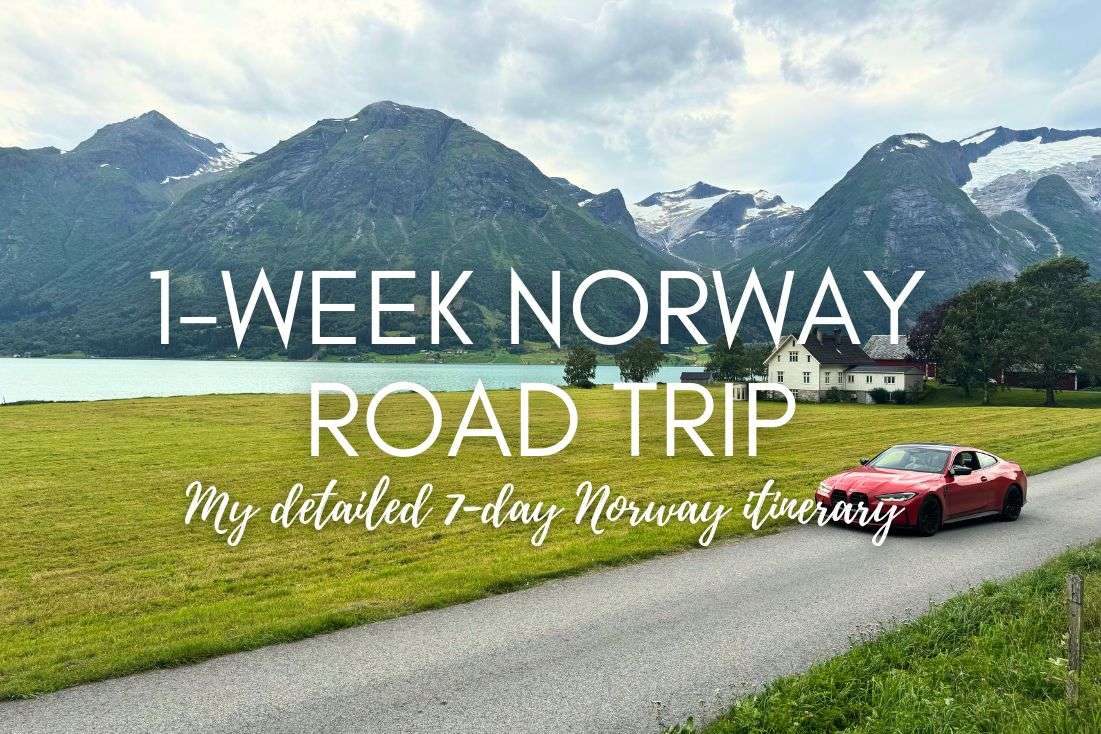
Is it really possible to see Norway in 1 week? Yep! My girlfriend and I gave it our best shot, and this 7-day Norway itinerary is what we came up with: a fast-paced, no-nonsense Norway road trip that crams in fjords, mountains, waterfalls, and hikes, with minimal downtime.
This is hands-down the best way to see Norway without living out of a car for months. It’s ambitious, sure, but totally worth it if you want to see everything this ridiculous country has to offer in record time. Buckle up—this 1-week Norway itinerary will keep you moving, but it’ll be an experience you’ll never forget!
Learn even more about Norway right here...
The best 1-week Norway itinerary: outline
- Day 1: Lysefjord and Pulpit Rock hike
- Day 2: Folgefonna glacier hike
- Day 3: Trolltunga hike
- Day 4: Flåm
- Day 5: Aurlandsfjord and Nærøyfjord
- Day 6: Besseggen Ridge hike
- Day 7: Oslo
Sometimes, all you need to do is take the first step... I've filtered out the best hotels in Norway for you
Save it for yourself to come back to later, or share with your friends on social media!
Your Norway road trip: map
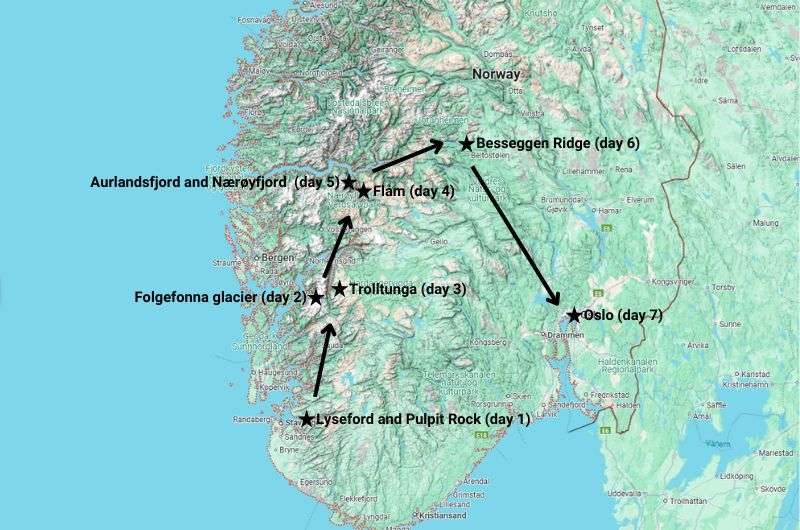
Route map of my 7-day Southern Norway itinerary
My essential tips for spending 1 week in Norway
- If you’re wondering whether you’ll see enough of the fjords on a week-long Norway road trip, the answer is yes. And then some.
- Pack for every season, all at once. Norway's countryside goes through mood swings like a diva. Warm sunshine at noon, rain by 2 pm, and snow if you're really lucky. In short, expect cold weather, and layers are your best friends.
- Check webcams before you set out. If you want to avoid the disappointment of fog ruining your epic view, online camera-views are your crystal ball.
- Be early, beat the rain. Morning excursions are golden—crisp air, empty trails, and usually dry weather.
- Gear up. Make sure you have sturdy, waterproof hiking boots, a rain jacket, and a reliable backpack. Bonus points for bringing trekking poles and a reusable water bottle. Norway’s tap water is fresher than most bottled brands!
- Costs are bearable. Overall, Norway is about twice as pricey as other Western European countries, but it’s not outrageous. You can manage—I thought Israel was way worse!
- Hotels aren’t amazing and the less said about restaurant service, the better. Lower your expectations. Overall, the best place that I stayed at on this itinerary was probably Vangsgaarden Gjestgiveri in Aurland.
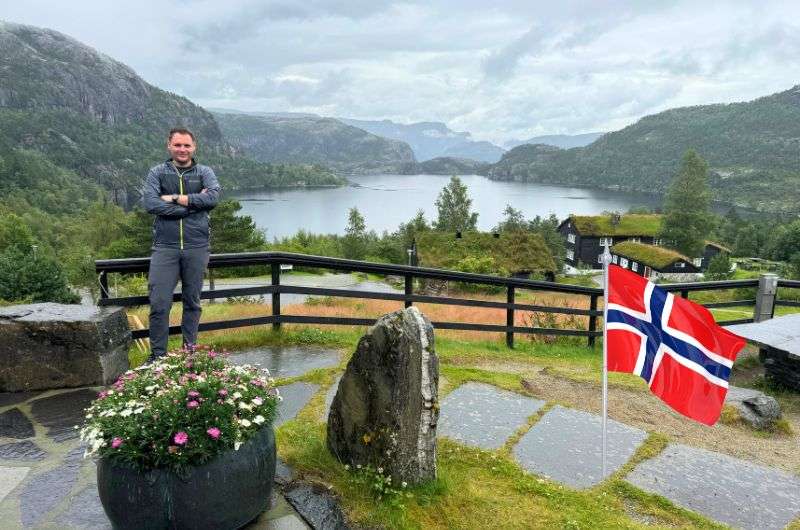
Your guide to a fabulous week in Norway
Tips on driving in Norway (because this deserves its own section)
- Prepare yourself mentally for a fair amount of driving. The average speed is around 70 km/h (43 mi/h), and people stick to it strictly. Norwegian drivers can be a bit rude, rarely yielding or making room, and they drive some hella flashy cars.
- Tunnel vision—literally. Prepare for Norway’s epic love affair with tunnels. You’ll drive through enough to feel like a mole, but hey, they cut travel time and often pop out into stunning scenes. However, you have to pay a toll on some of them; follow the instructions to register your car at epass24.com. If you’re driving a rental car, the car rental company should bill you.
- Budget and plan ahead for parking. Parking in the Norwegian countryside can be shockingly expensive and often limited near popular trails or viewpoints. Use official parking lots (even if pricey) to avoid fines and always check if payment is app-based—many spots don’t take cash!
- Ferries are your friends. They’re efficient, frequent, and surprisingly chill. Register your car on ferrypay.no and enjoy the ride without hassle.
- Sensible centrism...? Gas prices in Norway are dynamic, but they’re also the same everywhere, at every station.
- The driving-under-the-influence limit in Norway is 0.02%. In real terms, this means one beer. Don’t risk drinking more—fines are high.
- Above all, driving in Norway is a pastime in itself. Honestly, the journeys between stops were as memorable as the destinations themselves.
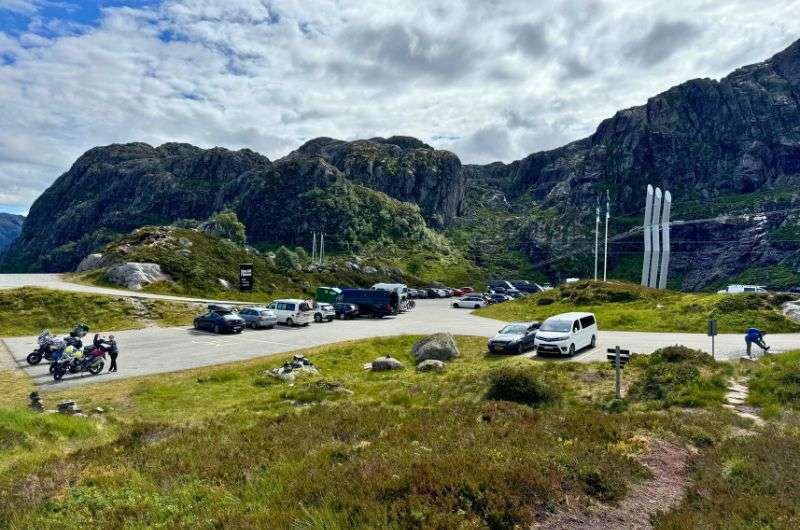
Prepare for lots of driving and long journeys... then again, even the parking lots are scenic
How to get to Norway to start your 7-day itinerary
- Option 1: fly to Oslo. Oslo is the capital of Norway and so from most places, the easiest city to reach via airplane. If you choose to rent a car in Oslo, allow 8 hours for the journey to Stavanger (where this itinerary begins). Alternatively, catch an onward domestic flight to Stavanger and pick up a car there.
- Option 2: fly to Stavanger. Stavanger Airport is the country’s third-busiest—you might be surprised by how many flights it gets. If you can find a connection to Stavanger that works for you, I’d say take it, as it’s by far the most convenient way to begin this Norway itinerary.
- Option 3: get the ferry to Kristiansand. This is the best thing to do if you want to come from mainland Europe with your own car. The ferry sails from Hirtshals in Denmark up to 39 times every week and takes around 3 hours. Then, allow 3.5 hours to drive to Stavanger from Kristiansand.
Where to stay in Norway on your 7-day itinerary
These are my hotel recommendations in the five places you should base yourself on this Norway itinerary...
- Night 1: Ydalir Hotel in Stavanger
- Nights 2 and 3: Trolltunga Hotel in Odda
- Night 4: Vangsgaarden Gjestgiveri in Aurland
- Night 5: Radisson Blu Resort in Beitostølen
- Nights 6 and 7: Voksenasen Hotell; Best Western Signature Collection in Oslo
Day 1: Lysefjord and Pulpit Rock hike
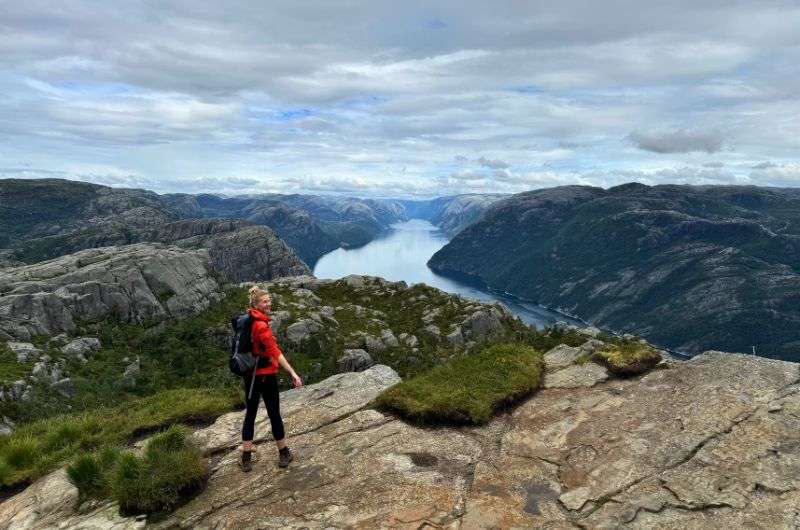
Here we go! Starting out strong on day 1!
Agenda for day 1:
- Go on a Lysefjord cruise (for 3.5 hours)
- Hike Pulpit Rock (for 6.5 hours, including drive time)
Hotel recommendation: Ydalir Hotel in Stavanger
Further reading: Things to do in Stavanger
Morning: go on a Lysefjord cruise
Operated by Rødne Fjord Cruise, this is the thing to do if you only have one day in the Stavanger area. Lysefjord is one of Norway’s most iconic fjords, so book online directly to avoid overpaying, and do it 2 to 3 days ahead since spots fill up fast.
Tickets are around NOK 1,590 (USD 60), and all you need is a QR code to board. The boat departs from the historic harbor, with plenty of parking nearby.
Tip: Check out info on the low-emission zones and parking fees before you roll into the city!
The three-hour cruise starts with an hour-long sail into Lysefjord, with an excellent audio guide dropping fun facts—none of that boring fluff. The boat is quiet, electric, and ridiculously smooth. Pack a jacket, though (and this isn’t the first time I’ll tell you), because it’s windy all year round.
But oh boy, what a way to kick off your 7-day Norway itinerary! The fjord’s icy waters plunge 460 m (1,509 ft) deep, and the towering cliffs are straight out of Yosemite-meets-Vancouver. Bonus points to Rødne Fjord Cruise for the luxury leather seats inside, but you’ll probably want to be on deck for the views.
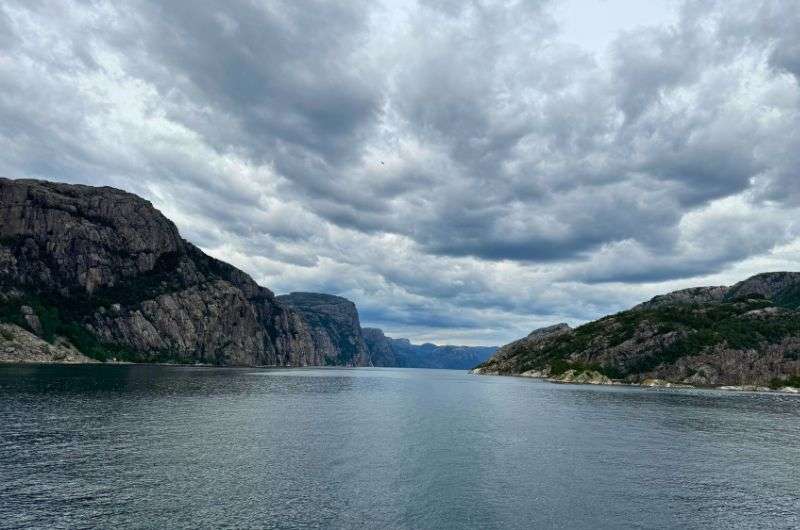
Panorama on the Lysefjord cruise
But what even is a fjord?... Okay, not to go too geography-teacher on you, but while we’re here: a fjord is a long, deep, and narrow body of water that extends inland from the sea, typically with steep cliffs or slopes on either side. They’re formed by glaciers, which carve out deep valleys as they move. When the glacier retreats, the sea floods the valley, and voilà—the fjord appears.
Pulpit Rock, which you’ll climb later, juts out onto this very fjord. The only slightly annoying thing about the cruise is that it doesn’t actually stop near the Pulpit Rock trailhead, meaning you have to drive back out again once you return to Stavanger. But it’s only a 45-minute journey, which in Norwegian driving terms, is basically no time at all.
Afternoon/evening: hike Pulpit Rock
Also known as Preikestolen, this cliff is an absolute bucket-list hike. On the drive from Stavanger, you’ll notice that the infrastructure is top-notch, with clear signs along the way and decent parking. (Just put “Preikestolen hiking starting point” into your GPS.)
The hike isn’t so hard—just 4 km (2.5 mi) each way, with an elevation gain of 398 m (1,306 ft). Expect granite paths, forest sections, and epic views along the way.
The trail’s well-maintained, even in the rain, but leave the sneakers at home—boots are your best friend here. Most of the climbing happens in the first 2 km (1.2 mi), so the toughest part is over pretty quickly, while you still have your strength.
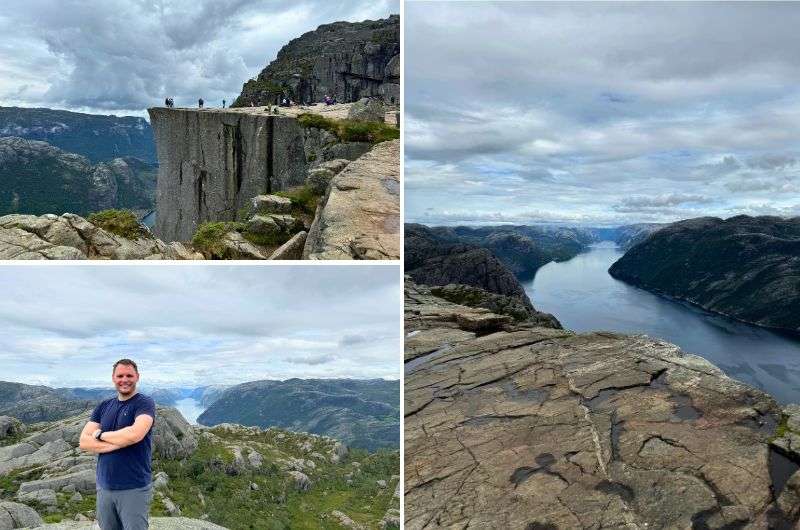
An hour and a half walk to these magical views
It takes about 1.5 hours to get to the top, but if you’re anything like me, you’ll want to linger along the way. But the summit is pure magic: a natural granite platform jutting out over Lysefjord. The 600-meter (1,969-foot) vertical drop will certainly test your fear of heights (even if you don’t claim to have one). It’s crowded, but the views are worth it—more of those Yosemite vibes you got in the morning.
Pro tips: Going later in the afternoon means you avoid the bus crowds (this is one of the most popular hikes to do in Norway, after all). And make sure you budget for tolls (NOK 164 [USD 15] one way) and parking (NOK 250 [USD 23]).
To sum up, this is hands down one of the most stunning hikes I’ve ever done—totally worth the hype! You can read about my experience hiking Pulpit Rock in more detail right here:

Day 2: Folgefonna glacier hike
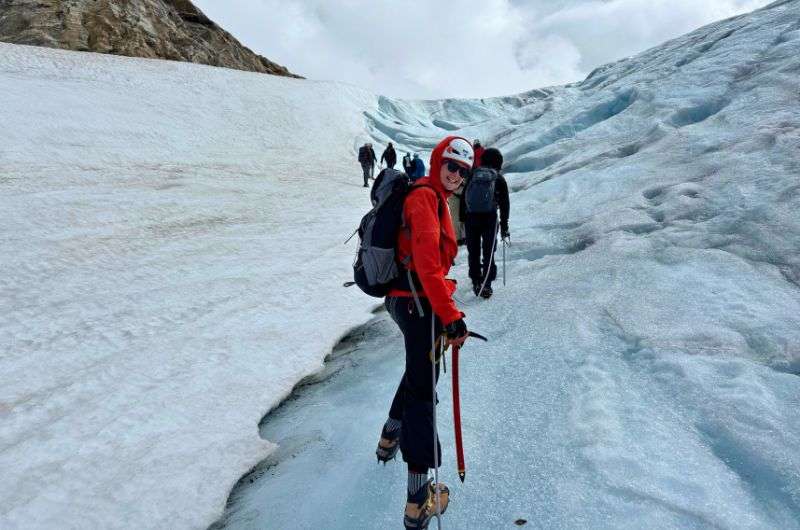
Let’s climb Folgefonna glacier!
Agenda for day 2:
- Drive from Stavanger to FONNA Glacier Ski Resort (for 5 hours)
- Hike Folgefonna glacier (for 6 hours, including drive time)
Hotel recommendation: Trolltunga Hotel in Odda
Further reading: My top 10 hikes in Norway
Morning, stop 1: drive to FONNA Glacier Ski Resort
It’s the second day of your itinerary—time to start the Norway road trip! Next stop, the Hardangerfjord area. What does this mean? Glaciers, basically. (Or, if you like, unborn fjords!)
Allow 5 hours to reach FONNA Glacier Ski Resort (Google Maps link), where the guided Folgefonna hike begins. This means a very early start from the hotel in Stavanger, as the tour begins at 11 am. And make sure you layer up for when you get there! You don’t need to be a weatherman to know that it’ll be cold atop a massive glacier.
This drive starts with smooth coastal roads, where the sea flirts with jagged cliffs, before weaving through more pretty villages. Before too long, it’s ferry time, from Mortavika to Arsvågen.
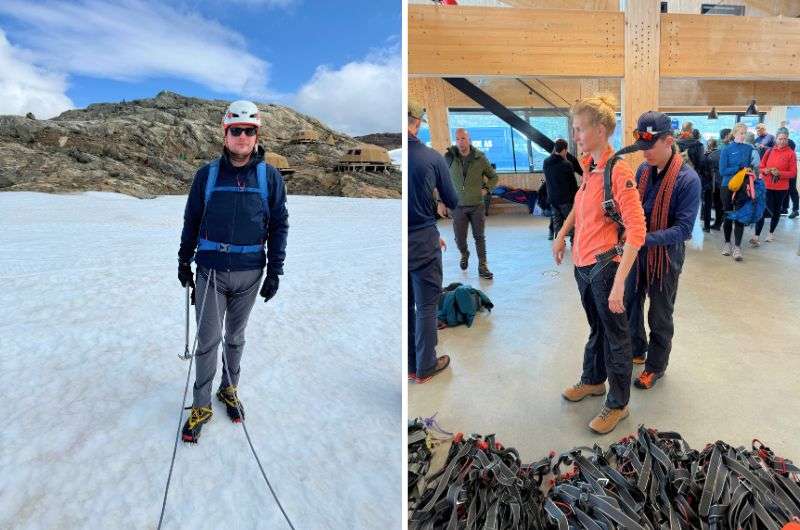
Gearing up before the hike
Practical note on Norway’s ferries: They're like big car buses, mostly operated by Fjord1. They’re medium-sized, punctual, and have restrooms and food onboard. You don't book in advance, but you should register your car’s license plate online at ferrypay.no.
Once you're over the water, the real fun begins! The road climbs into alpine territory, where bright white waterfalls crash and tunnels cut through mountains like butter. By the time you reach FONNA, you’re 1,200 m (3,937 ft) above sea level, and the air is crisp enough to make you feel thoroughly refreshed after the journey.
Morning/afternoon, stop 2: hike Folgefonna glacier
First off, a PSA: You can only hike Folgefonna as part of a guided tour in summer. (This is a huge hint that the best time for this Norway itinerary is summer.)
We went with Go Fjords—for NOK 1,905 (USD 174), they take you on an epic 5-hour blue-ice tour, which includes rental of ice hiking equipment.
Fun fact: Folgefonna is a maritime glacier, fed by massive rainfall from Norway’s west coast (via the city of Bergen, Europe’s unofficial rain capital). Its crevasses aren’t too deep, around 25 m (82 ft) at most, and I can confirm that walking on it is a really cool experience—figuratively and literally.
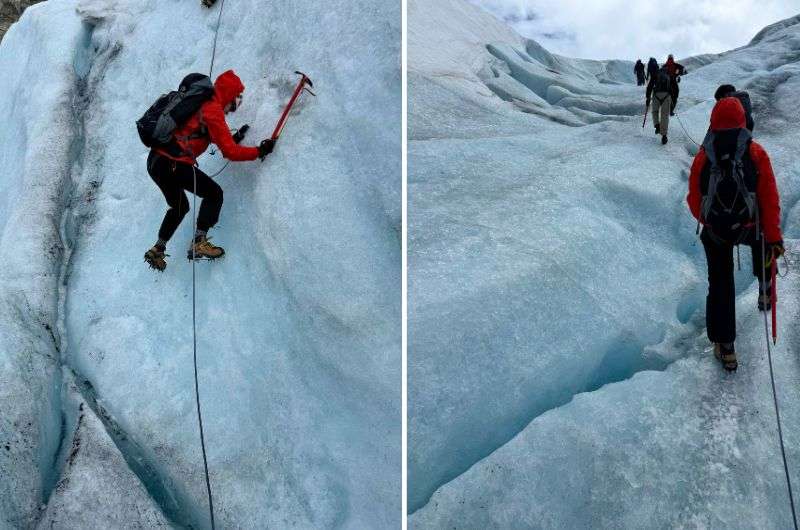
Climbing Folgefonna is no walk in the park
As far as the trail conditions go, you’ll be walking on ice, so expect uneven surfaces and meltwater streams. Follow your guide’s instructions, as venturing off the designated route can be dangerous.
The guides are absolute pros, though, so no need to stress if you’re a total newbie. They’ll walk you through every step, crampons and all. We lucked out with the weather—it had been closed for days, and we were the first group to get a green light!
Here are some other things you need to know before hiking Folgefonna glacier:
- Officially, tour groups are capped at 10 people, but we had 12 in ours, and constantly needing to adjust the rope was a pain. If you can afford it, go for a private guide—it’s quicker, more tailored, and less annoying.
- Learn how to use ice axes beforehand if possible—it’ll save you time and stress.
- The hike is 8 km (5 mi) round trip with a 500 m (1,640 ft) elevation gain. Moderate in principle, but trust me, it can get hardcore fast.

Day 3: Trolltunga hike
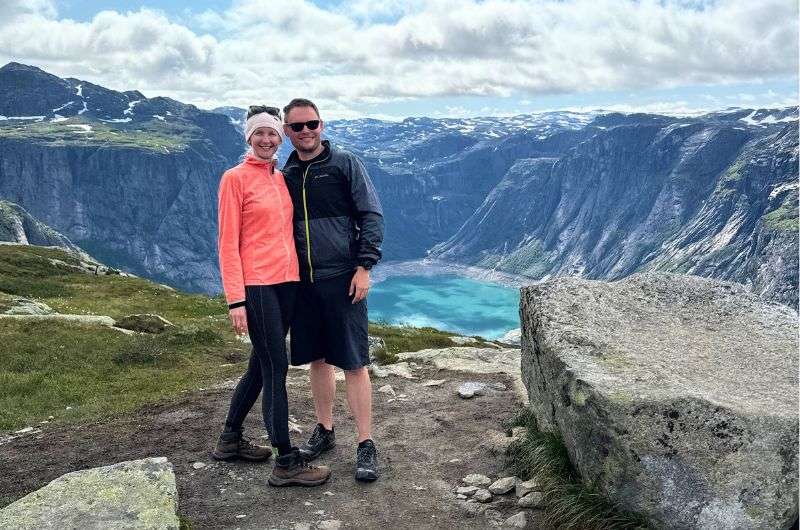
Troll’s Tongue
Agenda for day 3:
- Hike Trolltunga (for 9.5 hours, including drive time)
Hotel recommendation: Trolltunga Hotel in Odda
Further reading: My guide to the Trolltunga hike
Morning/afternoon: hike Trolltunga
This is one of Norway’s most challenging, but also most iconic hikes. If you’ve never seen any pictures of Trolltunga, it’s a narrow cliff platform perched 700 m (2,297 ft) above Ringedalsvatnet lake. And if you’ve ever wanted to feel like you’re standing on the edge of the world, and like your heart is about to jump out of your mouth, this hike is definitely for you.
Fun fact: Trolltunga means “troll tongue”. As the legend goes, the rock got its name from a big-headed troll who believed he was immune from the sun’s power to turn things into stone. The troll waited for the sun to appear and stuck his tongue out to mock it. Lesson learned, kids—don’t mess with the sun!
To drive to the trailhead from the hotel in Odda is a straightforward, 20-minute job. But because it’s such a popular hike, parking is a pain in the ass. Book at least a month ahead for a spot—not kidding.
What you need to know about parking for Trolltunga: There’s a good chance that P3—the parking lot at the actual trailhead—will be full. This means you’ll probably park at P2 (for 500 NOK [USD 45]), which means either an extra 90-minute hike or catching a shuttle bus for NOK 150 (USD 14).
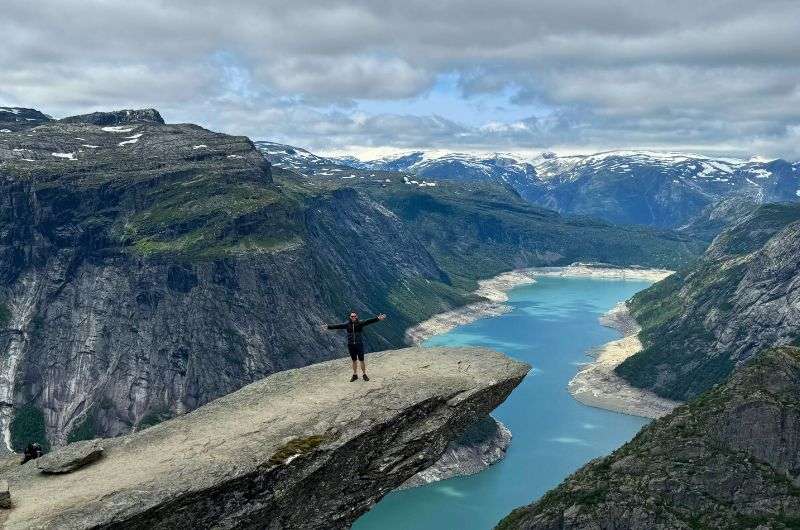
King of the world!
I’ll say it louder for the people in the back: take the shuttle bus! We didn’t and soon regretted it because we wore ourselves out unnecessarily.
The trail itself is idiot-proof—clearly marked and easy to follow. The first 2.5 km (1.6 mi) are the toughest, climbing from 330 m (1,082 ft). But the scenery gave us plenty of excuses to stop. And what incredible scenery it is! The weather was clear, and we got some stunning glimpses of the valleys and lake below, making us almost forget the fact that our legs were on fire.
After that, you're rewarded with smooth sailing along a rocky plateau with stunning mountain-and-lake views. It did start to get to me mentally, though. There was a point when I started to zone out—a middle-ground feeling of having done a lot and yet still having so much further to go. It’s not a technically difficult hike; just long—it takes around 3.5 hours to the top if you’re moving steadily.
The feeling of finally reaching the tongue was monumental. Just as it does in the photos, it juts out over the lake below, like nature’s own diving board. (Disclaimer, just in case you’re that dumb: it’s definitely not a diving board.)
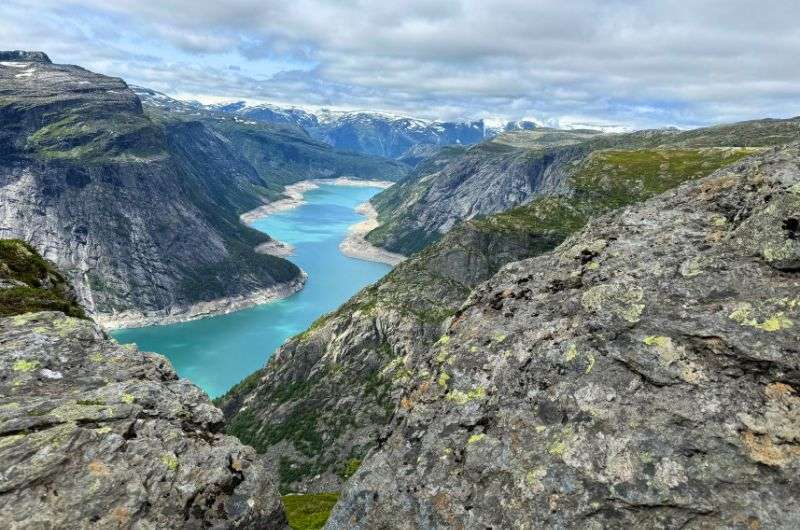
Breathtaking views @ Trolltunga
Pro tip: Leave EARLY—this is especially pertinent to Trolltunga. We started at 8:30 am and still waited 30 minutes in line for that iconic photo on the cliff tongue. For even fewer crowds, consider camping for the earliest start, or timing your Norway itinerary so that this day falls on a weekday.
Honestly, although it was hard work, this hike was the perfect way to round off our stay in the Hardangerfjord area, so I can’t recommend highly enough that you do the same.

Day 4: Flåm
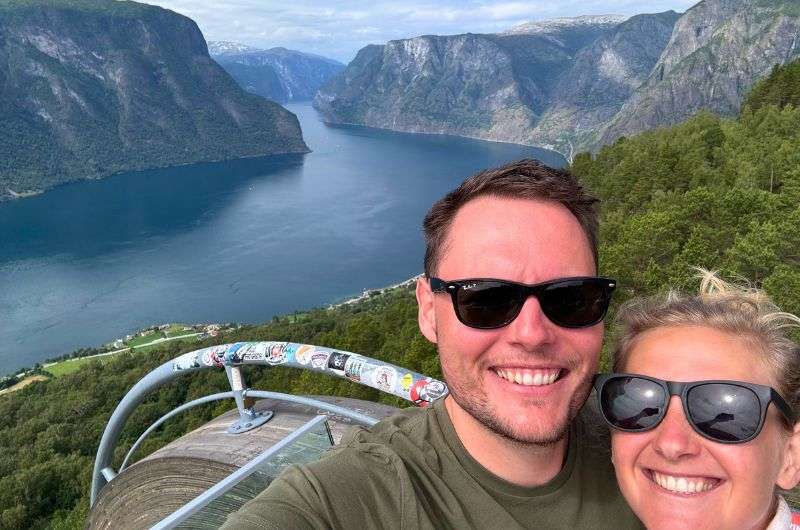
Flåm also bringing the scenery
Agenda for day 4:
- Drive from Odda to Aurland (for 2.5 hours)
- Visit “Viking Valley” in Gudvangen (for 2.5 hours, including drive time)
- Hike to Brekkefossen (for 1.5 hours)
- Ride the Flåm Railway (for 1.5 hours)
- Drive to the Stegastein Viewpoint (for 45 minutes)
Hotel recommendation: Vangsgaarden Gjestgiveri in Aurland
Further reading: 11 fun things to do in Flåm
Morning, stop 1: drive to Aurland
Flåm, a small town at the end of Aurlandsfjord, is one of the places people come to when they’re on a “Norway in a nutshell” tour. Yep, the popular, pre-arranged, best-of-Norway itinerary that includes Oslo, Jotunheimen, and maybe Bergen, also includes Flåm and the surrounding area. That should give you an idea of how good it is—an obligatory stop on your Norway road trip.
This car journey (Google Maps link) is only two and a half hours. (By Norweigan standards, that’s practically right next door!) We waved goodbye to Hardangerfjord, cruised through some snow-dusted peaks, and said hello to Aurlandsfjord and Nærøyfjord. These are Norway’s prettiest cousins, joined in a sort of wishbone formation on the map.
Instead of staying in Flåm itself, we got some accommodation in Aurland (the next village along, 10 minutes’ drive away). Why? Because in Aurland, it’s less busy, there are no monstruous cruise ships docking in your view, and it’s cheaper.
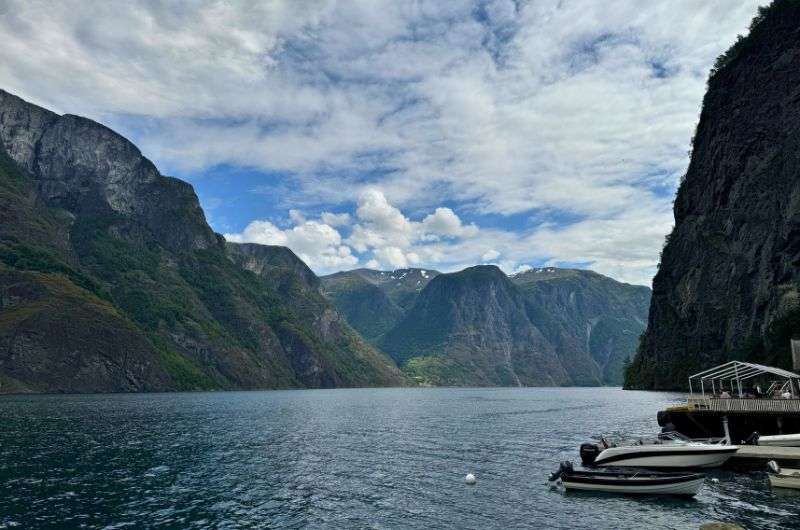
Aurlandsfjord
As I mentioned earlier, Vangsgaarden Gjestgiveri is honestly one of the best places I’ve ever stayed at in Norway. It’s cute and modest—a row of modern, comfy rooms in little individual huts that once belonged to fishermen. And these huts really have got it all: unique charm, a fjord view, and not to mention the perfect breakfast.
Morning, stop 2: visit “Viking Valley” in Gudvangen
The “Viking Valley of Njardarheimr”, tucked into the bottom of Nærøyfjord against the most picturesque backdrop, feels like a (staged) Norse retreat. At this open-air museum, the staff stay in character as “Viking villagers”, and guest participation is their game. Okay, it’s a total tourist trap, but they’re nailing the vibe they go for.
You’ll find this weird Viking village just a 20-minute drive from Flåm or a 25-minute drive from Aurland. (Google Maps link). Tickets are a reasonable NOK 235 (USD 21), and the whole place is interactive, with archery, axe throwing, and even “Viking food” to try. We were like kids in a candy shop beneath the grass-roofed huts, learning all about Viking gear, ships, and everyday life.
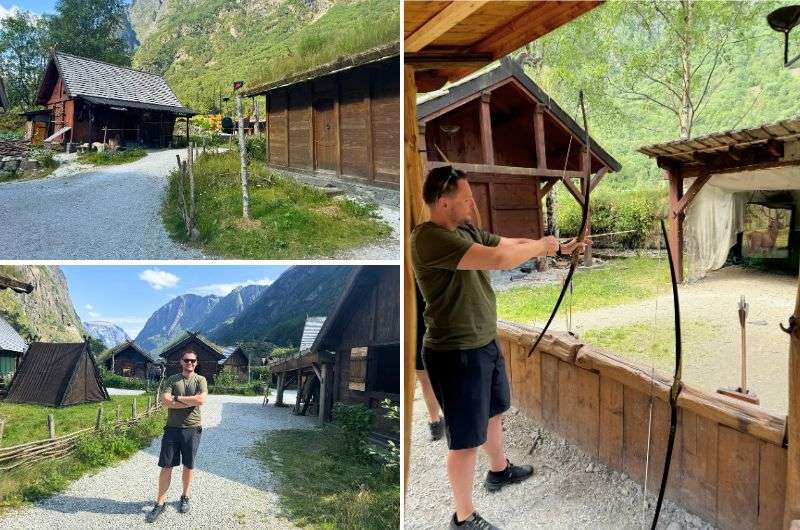
Having fun in Viking Valley
For instance, did you know that Vikings weren’t a nation of people, but seafaring warriors? Their gear—shield, axe, spear, and dagger—doubled as farm tools, and missing equipment could land them fines. Helmets? Super rare. Swords? So costly that only a few of the elite had them.
You’ll find this wacky Viking village just a 20-minute drive from Flåm or a 25-minute drive from Aurland. And one last piece of advice: This is an absolute must for your Norway road trip if you have kids!
Afternoon, stop 1: hike to Brekkefossen
It was back to Flåm for us in the afternoon, and despite having come from Trolltunga less than 24 hours prior, I was craving another hike. I’d read that the trek to the Brekkefossen waterfall is short—2 hours maximum—but it packs in enough elevation to make you break a sweat. Perfect!
The trail immediately goes vertical from Flåm (as you might notice, gentle slopes aren’t really a thing around the fjords). It then winds through lush greenery before opening up to a stunning panorama of the Flåm Valley, Flåm itself, and Aurlandsfjord.
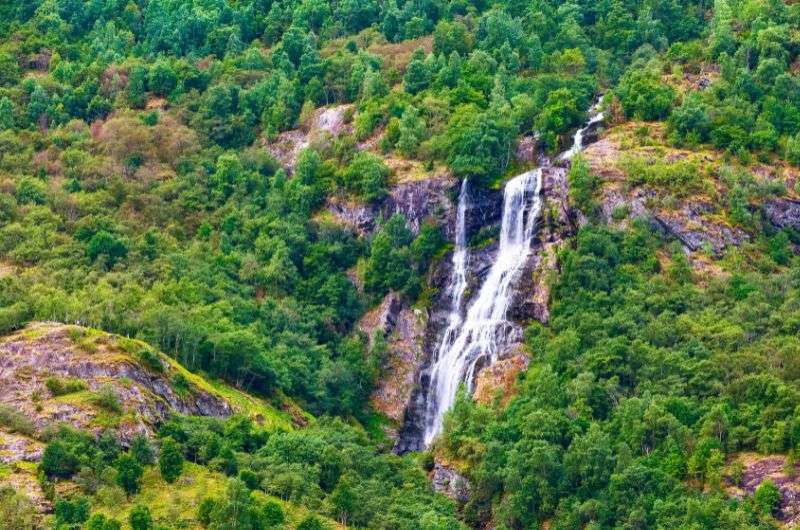
Brekkefossen waterfall
Brekkefossen itself is a thunderous, picture-perfect waterfall that feels refreshingly close to the raw nature of Norway without the need for a day-long expedition. The terrain alternates between rocky and muddy, especially if it’s rained recently (which, this being Norway, is probably the case).
Important tip: This may seem like a tame hike, but you still need to wear good hiking shoes. Sneakers aren’t tough enough, unless you want to join Brekkefossen at the bottom.
We actually only hiked one way, jumping on a sweet and special ride that’d take us the rest of the way up the valley. If you’ve been Googling around for things to put on your 7-day Norway itinerary, you might have heard of this already...
Afternoon, stop 2: ride the Flåm Railway
The Flåm Railway (Flåmsbana) is one of Norway’s top attractions, dubbed “one of the world’s most beautiful train journeys”. It goes from Flåm at sea level to the too-small-even-to-be-a-village of Myrdal, at 860 m (2,822 ft). And back down again, naturally.
Fun fact: Running on a gradient of 5.5%, the Flåm Railway is one of the world’s steepest standard gauge railway lines. But it’s perfectly safe!
You get to see one of the most beautiful fjords in Norway, as well as the scenery that surrounds it, while exerting very little physical effort. Think of it like a city tour bus, except without an open top deck, and with the opportunity to try sveler (Norwegian pancakes) on board. In short, it’s a genius idea for lazy tourists.
As I say, we skipped out on the pancakes, opting to hike half the way and board the train at Lunden (Google Maps link), in order to see Brekkefossen first. Hack: If you want to get to Brekkefossen without sweating, take the Flåm Railway the opposite way, getting off the train returning from Myrdal at Lunden. It’s then only 10 minutes’ walk to the waterfall, and then it’s all downhill back to Flåm.
I’ll be honest, the Flåm train ride is a fun thing to do and all, but it really is all about the journey. The fjord views you get from Myrdal at the top of the valley are nowhere near as good as the ones you get down by the water itself.
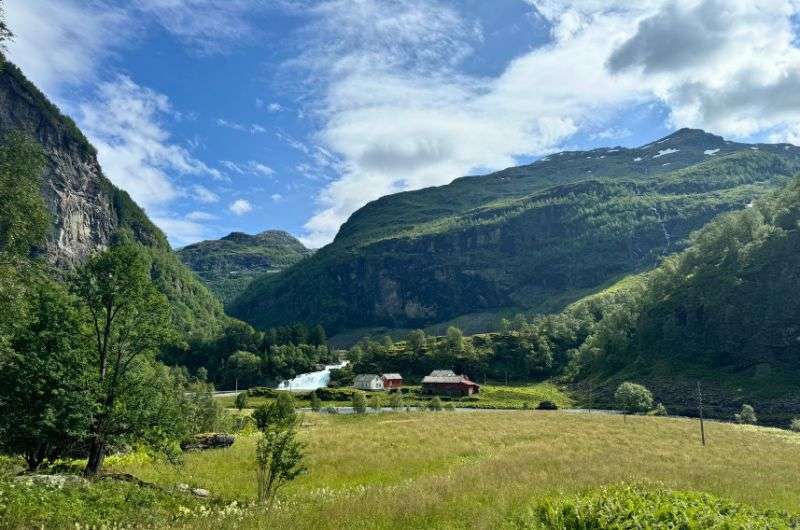
Panoramic train journey through Flåm
Pro tip: There are several tourist companies that offer Flåm Railway tickets, but go directly with the operator, vy.no, for the cheapest deals.
Bonus: If you want to learn more about this impressive train track, have a look around the Flåm Railway Museum right by the station terminal. It’s free to enter and they offer a guided tour in 9 different languages.
Afternoon/evening, stop 3: Stegastein Viewpoint
Having left the car in Flåm by the waterfront (honestly, with how busy it can get there, finding a spot felt like I’d won the lottery), we then drove to our final stop on day 4. Perched a stomach-churning 650 m (2,133 ft) above Aurlandsfjord, the Stegastein Viewpoint is a long platform built to offer views of Aurlandsfjord and the mouth of Nærøyfjord.
Expect an 8-kilometer (6.4-mile) one-way road from Aurland that demands patience. But it’s worth it, especially in the morning or evening when there are fewer crowds and the sunrise or sunset makes your surroundings even more epic! Honestly, this is the best way to top off any day of adventure in the Flåm area.
Note: If you choose to drive up during the day, you’re likely to encounter traffic jams. Also, be aware that the parking lot is small. Even though we didn’t go at peak time, we had trouble finding a place (though it wasn’t quite as difficult as it was in Flåm).
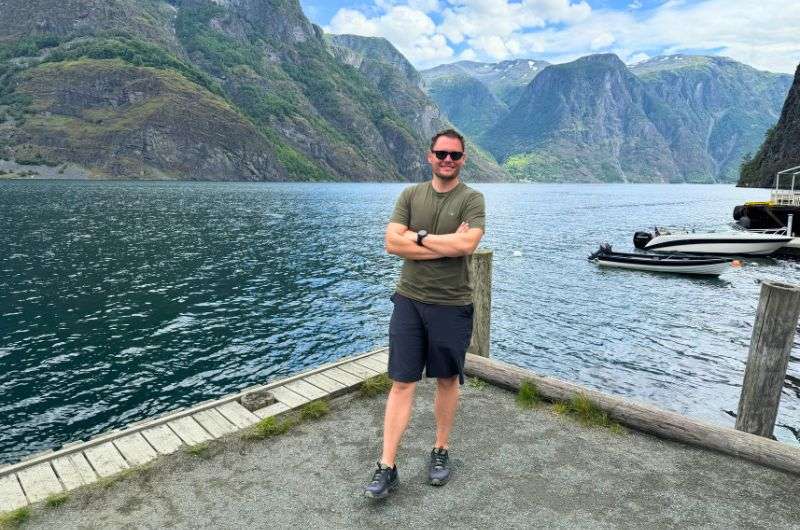
On the Stegastein viewpoint
Honorable mention: the Flåm Zipline
At 1,381 m (4,531 mi), this is the longest zipline in the Nordic countries. This bad boy will send you down the picturesque Flåm Valley at a maximum speed of 100 km/h (62 mi/h). You get the idea; if you’re a thrill-seeker, you should try and fit this into your itinerary.
Did I try it? Hell no—I’d rather not pay NOK 800 (USD 73) to soil myself, thank you. But still, I can’t argue that this shouldn’t be mentioned when it comes to the top things to do in Flåm and around Aurlandsfjord.
To get to the start of the zipline, you need to reach Vatnahalsen in the Flåm Valley, about a 45-minute drive inland from Aurlandsfjord. The zipline ends in a tiny place called Kårdal.
Pro tip: Combine this with a ride on the Flåm Railway, as Vatnahalsen is close to Myrdal. Once you reach Kårdal on the other end of the zipline, you can get back down to Flåm and Aurlandsfjord by hiking or by renting a bike.

Day 5: Aurlandsfjord and Nærøyfjord
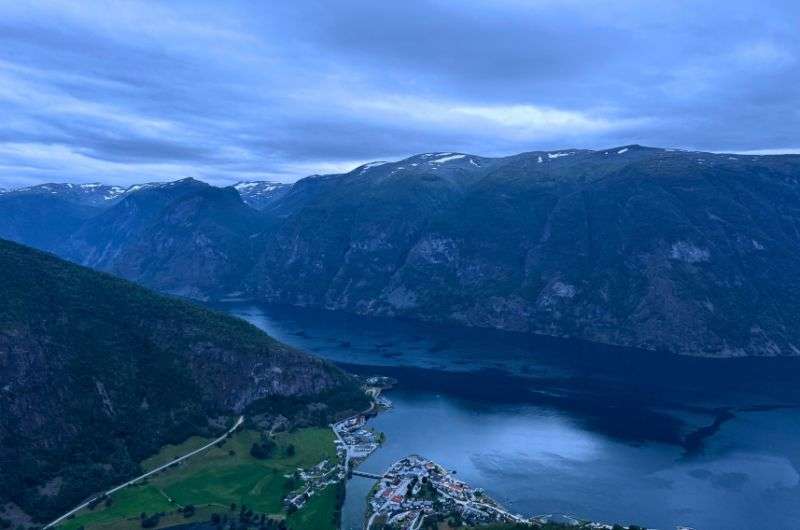
Aurlandsfjord
Agenda for day 5:
- Rent a motorboat on Aurlandsfjord (for 3 hours)
- Drive from Flåm to Beitostølen (for 2.5 hours)
Hotel recommendation: Radisson Blu Resort in Beitostølen
Further reading: The best fjords in Norway
Morning: rent a motorboat on Aurlandsfjord
What’s the absolute best way to experience Aurlandsfjord? Rent a motorboat and go solo! It’s roughly the same cost as a cruise or a so-called “fjord safari”, but you control what you see, where you go, and how long you stay on the water. I’m not the emotional type, but I swear, this was one of the most unforgettable experiences of my life.
The perspective from your own boat is a true game-changer. My personal highlight sights were the waterfalls, a pod of dolphins, and some massive sea otters. We even passed a cruise ship up-close, which was cool but mildly terrifying.
We rented from Flåm Boat Rental, right by the Flåm Marina restaurant (Google Maps link). The handover was easy and the boat was simple to operate—you don’t even need a drivers’ license (though getting this far on a Norway road trip without one would be a serious achievement). Honestly, the whole 3-hour experience was well worth the NOK 2,690 (USD 243).
The boat was bumping up and down at 40 km/h (25 mi/h), giving us a proper thrill. According to my wristwatch, we managed to explore 62 km (39 mi), reaching Nærøyfjord—the other side of the fjord wishbone.
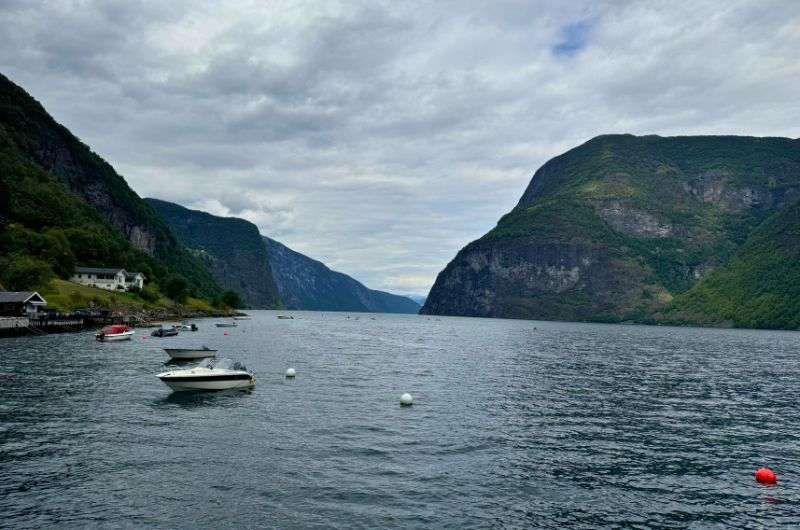
Rent a motor boat and cruise the Aurlandsfjord
Tip: The inner sections of both fjords are by far the prettiest areas to explore. As they get wider, the cliffs start leveling out.
Practical tips: As always when in rural Norway, dress warmly! The fjord water is cold (shocker), and your cruising speed will add some serious wind chill. And ladies, bring a seat cushion. Take it from my girlfriend.
Afternoon: drive to Beitostølen
Satisfied that we’d hit all the best things to see around Flåm and Aurlandsfjord, we thought we’d press on and do the next long drive in the afternoon, for once. We wanted Day 5 of our 7-day Norway trip to be relatively relaxed on the basis that the following two days would be pretty action-packed.
From or cabin in Aurland to Beitostølen, a village in Jotunheimen National Park, the whole journey took little over one hour (Google Maps link). Fair warning: you go from fjords to mountain plateaus so fast, your ears might pop. Other than that, it’s a drive packed with the usual Norwegian classics: waterfalls, winding roads, and on occasion, goats casually blocking traffic.
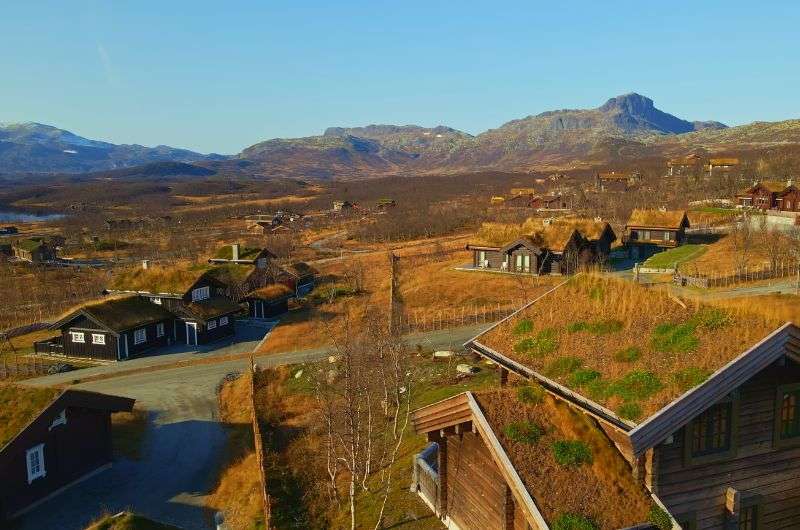
Beitostølen
Why did we choose to stay in Beitostølen? Well, we’d left the following day on the itinerary wide open to hike Besseggen Ridge. There aren’t any major towns near the Besseggen Ridge, so Beitostølen is about as civilized as accommodation gets (read: there are hotels with proper beds), just 34 km (21 mi) south of where the hike begins.
We went for the Radisson Blu Resort and sure, I’d recommend it. We got a clean room, a comfortable bed, and a good breakfast. Plus, they have a pool, so it was both refreshing and relaxing to take a dip there after several long days of driving, hiking, and speeding in a motorboat.

Day 6: Besseggen Ridge hike
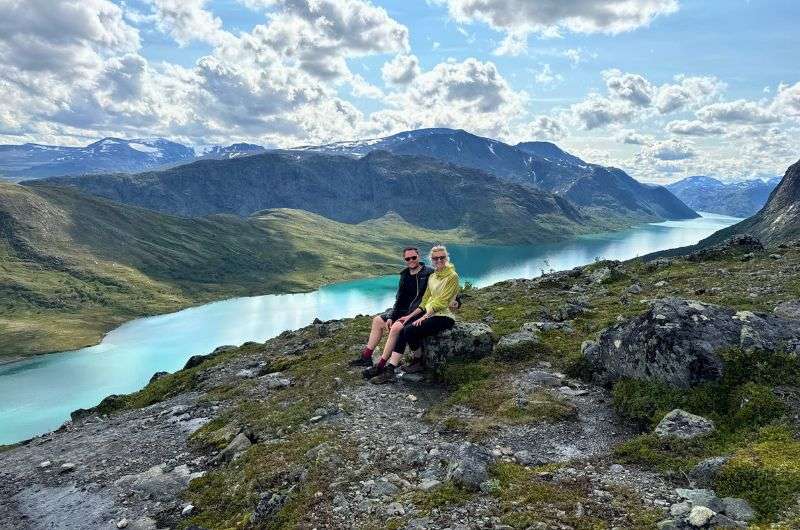
Besseggen Ridge hike could be the best for last
Agenda for day 6:
- Hike Besseggen Ridge (for 7 hours)
- Drive from Gjendesheim to Oslo (for 4.5 hours)
Hotel recommendation: Voksenasen Hotell; Best Western Signature Collection in Oslo
Further reading: My experience on the Besseggen Ridge hike
Morning/afternoon: hike Besseggen Ridge
Might I have just saved the best Norwegian hike ‘til last? To be honest, for me, it’s a tough call between Besseggen Ridge and Pulpit Rock. I’ll let you decide for yourself, because I’m brilliant and I’ve included both of them in your 7-day Norway road trip itinerary!
Once you get to Gjendesheim, the Besseggen Ridge trailhead, you need to take a shuttle bus from the large parking lot, 1.5 km (0.9 mi) away from the harbor. Yep, apparently, this iconic point-to-point trek pairs perfectly with a ferry ride across Gjende lake.
This means that there are technically more trailheads than one. It’s a bit complicated, but to see where exactly the different starting points are, read this detailed article on the Besseggen Ridge hike.
But bascially, it’s up to you whether you get the ferry first and hike back, or the other way around. My advice? Hike first, like we did. Although coming down the ridge was tough, I was happy to have the steepest uphill climb over with right at the beginning. Plus, there’s something really satisfying about hopping on a boat to cruise past the same mountain you’ve just conquered.
The trail itself is well-maintained, with steps and smooth descents in parts, but it’s no walk in the park. And it’s busy—it’s like a human highway.
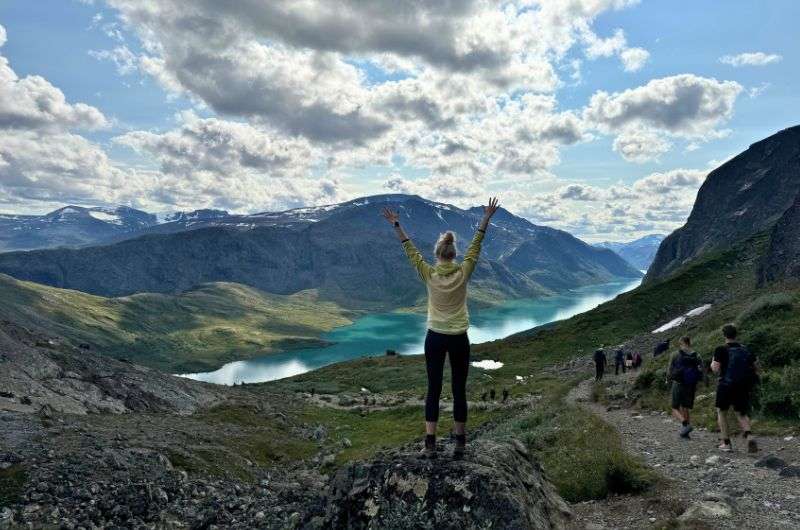
Besseggen Ridge hike views are so good they almost look unreal
Tip: Set off on the trail as early as you can, and ideally on a weekday, to have the best chance of avoiding the crowds.
Most people choose to do this hike in the opposite direction, but either way, the scenery will blow your mind. The views of Gjende lake and the surrounding peaks are simply insane. And walking along a narrow pass between two bodies of water did make me feel like Jesus—powerful, unstoppable, and proud.
Afternoon/evening: drive to Oslo
If you’re anything like me, at this point, you’ll be enduring a substantial hike comedown having just completed Besseggen Ridge—the final hike on this 7-day Norway itinerary itinerary. But do you know what I find takes the edge off the post-trekking vacation depression? Why, another long evening drive, of course!
To get the most out of Oslo, you need at least one full day in the city, so you’ll thank yourself for making this 4.5-hour journey the day before, rather than the morning of.
It was a relaxing way of easing us back into reality. Through the mountains, the forests, the rivers and the lakes, the dusk glow on the horizon signaled not just the end to another day, but the end to another absolutely fantastic trip to the Norwegian wilderness. I half expected credits to start rolling on the car hood in front of me, kind of like the Star Wars titles.
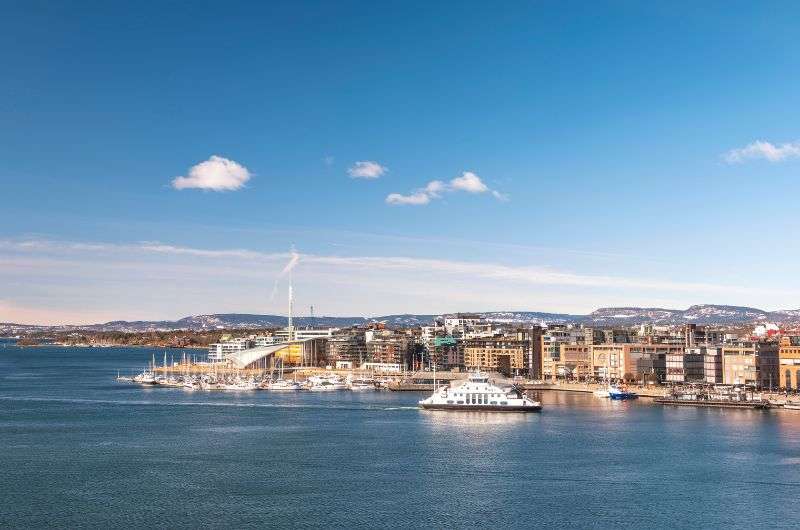
Let’s end the road trip in Norway’s capital
Once we reached Oslo, we checked into the Voksenasen Hotell; Best Western Signature Collection. In keeping with gently introducing ourselves back into reality, this place is a little way out of the city center in the northwest, atop the Voksenåsen hill. What does that mean? More stunning views!
Aside from the views, although the rooms are small and simple, our bed was comfortable and the breakfast buffet was varied and tasty. Also, it’s handy that this place is served by a metro station, Voksenkollen, less than 1 km (0.6 mi) away.
Day 7: Oslo
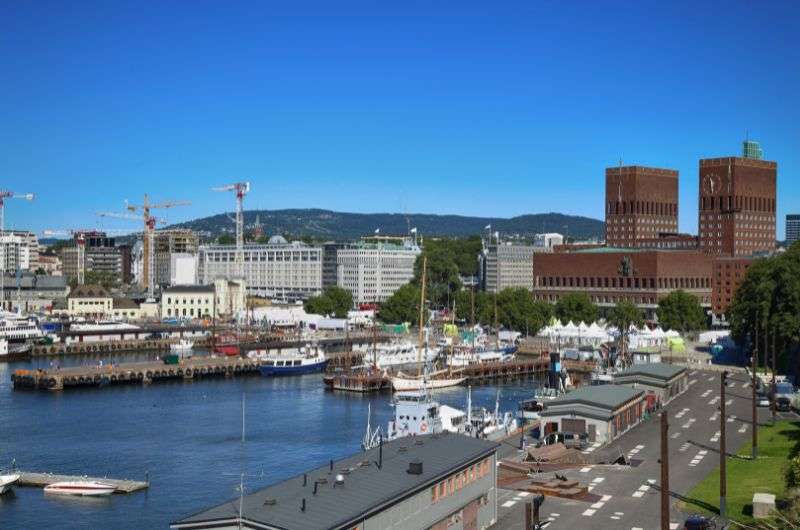
Oslo
Agenda for day 7:
- Visit the Norwegian Museum of Cultural History (for 3 hours, including travel time)
- Visit Oslo Cathedral (for 1 hour, including travel time)
- Visit Akershus Fortress (for 1 hour)
- Explore Hovedøya island (for 3 hours)
- Climb on the Opera House (for 20 minutes)
- Go fine dining (for 2 hours)
Hotel recommendation: Voksenasen Hotell; Best Western Signature Collection in Oslo
Further reading: Must-see places in Norway, according to me
Oslo sightseeing map
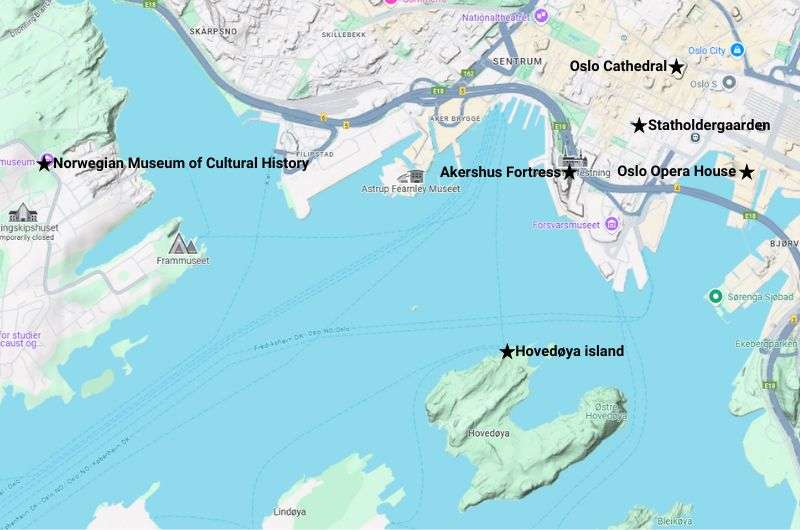
Partial map of Oslo, pinpointing all the best things to see in 1 day
Morning, stop 1: the Norwegian Museum of Cultural History
First off, some advice before you even set foot out of the hotel: Leave the car today—you don’t want to be paying Oslo prices for parking. Moreover, you don’t want to spend half the day weaving around an unfamiliar capital city while you burn through that dynamically-priced gas.
You can reach the center of Oslo in around 40 minutes on the metro (Google Maps link). Most of the sights for day 7 are then within walking distance, or else, take advantage of the integrated transport system operating in Oslo and Akershus.
Pro tip: Download the Ruter app for route planning and ticket information in your pocket.
Now that’s the practical stuff over with, I first wanted to make a beeline for the Norwegian Museum of Cultural History, simply because I just can’t resist an open-air museum. This one has over 150 historic buildings, including a stave church, farmhouses, and a few random artifacts. For NOK 180 (USD 16) a ticket, that’s fairly good value!
Fun fact: Founded in 1881, the Norwegian Museum of Cultural History was actually the world’s first open-air museum.
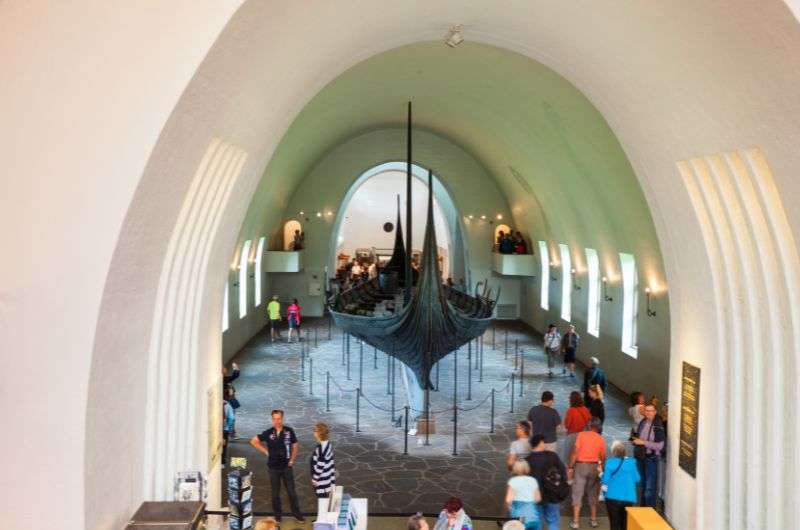
Norwegian Museum of Cultural History
On show here, it’s medieval history and onward, though it did remind me of Gudvangen’s Viking Valley. It positively sucked me in in the same way, anyway, as I didn’t really want to leave after just 2 hours. If you happen to have more time in Oslo at the end of this road trip itinerary, you should treat yourself to a whole afternoon at this museum.
Lastly, I have to mention that I was also dying to see the adjacent Viking Ship Museum, but it’s closed for renovation until 2027(!). I don’t think I’d been more disappointed by anything else throughout the entire trip.
Morning, stop 2: Oslo Cathedral
Oslo Cathedral (Oslo domkirke) is a 25-minute bus journey from the Museum of Cultural History, and this Baroque beauty is well worth a look inside (especially because admission is free).
The painted ceiling alone had me craning my neck like an amateur art critic, marveling at the intricate scenes that looked like they belonged in a fairy tale. And you can’t miss the stunning stained-glass windows or the impressive organ pipes. This place might just convert you into a cathedral fan, even if churches aren’t usually your thing.
Fun fact: This is where Norway does its royal weddings, so you’re literally walking in the footsteps of kings and queens.
Don’t worry—40 minutes is plenty of time at this stop. Take some pictures, light a candle if you’re feeling spiritual, and move on.
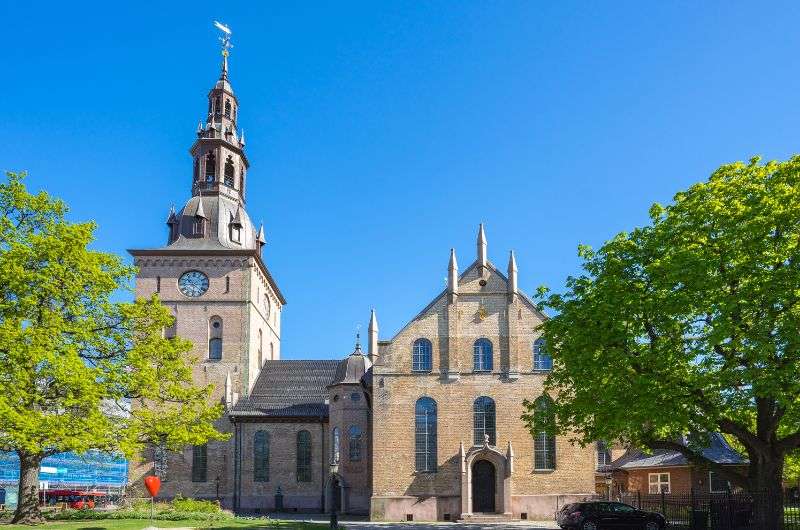
Oslo Cathedral
Afternoon, stop 1: Akershus Fortress
A short walk from the Cathedral brought us to Akershus Fortress, the city’s famous medieval castle that proudly overlooks Oslofjord. Built in the 13th century to fortify Oslo’s defences, this place has everything: cannons, dungeons, and centuries of history. Again, totally my sort of place!
Pro tip: You can go on a guided tour of Akershus Fortress at 12 pm or at 2 pm on Saturdays and Sundays. Sadly, we were there on a Thursday and had to fend for ourselves. On the upside, this meant we didn’t have to pay to get in.
We took our time wandering the grounds. This place has also served as a royal residence, a prison, and a military base, so the walls here have seen some serious drama.
If you’re lucky like we were, you might catch a guard change, or stumble into one of the fortress’s many hidden corners. I liked the dark prison cells that once held Norway’s most notorious criminals, and the mausoleum, where several members of the royal family have been laid to rest. All in all, the experience was a bit like Hogwarts meets Tomb Raider: entertainingly eerie.
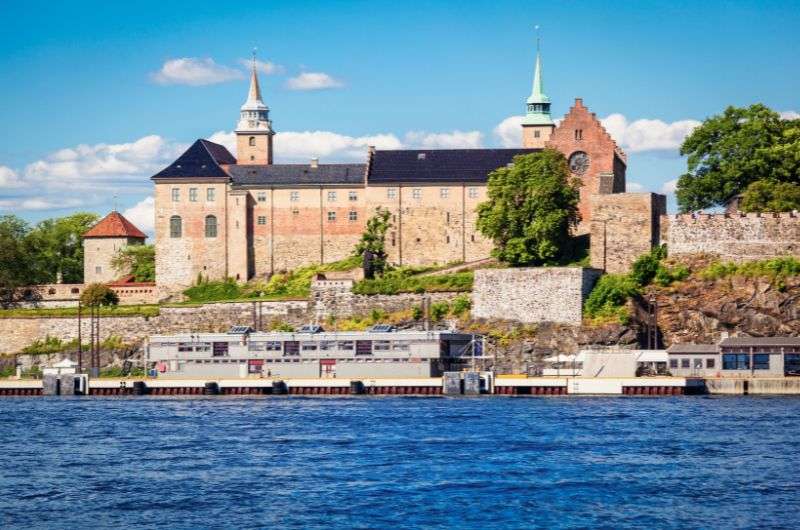
Akershus Fortress
Afternoon, stop 2: Hovedøya island
Just a short walk around the marina, and we reached Aker brygge (Google Maps link), where we boarded a ferry for a final mini adventure on this 7-day Norway itinerary. You can catch a boat (part of the transport network) to nearby Hovedøya island roughly every 20 minutes. We didn’t know what to expect at first, but it was a good mix of history and nature. They must have known I was coming...!
It was the brief, peaceful escape from the city on the mainland that we didn’t know we needed. We wandered through the ruins of a 12th-century Cistercian monastery, strolled along forest trails for scenic coastal views, and sunbathed on sandy beaches (while trying to ignore the wind). The one thing we didn’t do was go swimming, but if you can brave the cold water, it’s a good opportunity.
Tips: Keep an eye out for World War II bunkers and fortifications, reminders of the island’s storied past. And grab something from a nearby bakery before you board the ferry. A snack tastes so much better with a view of Oslofjord!
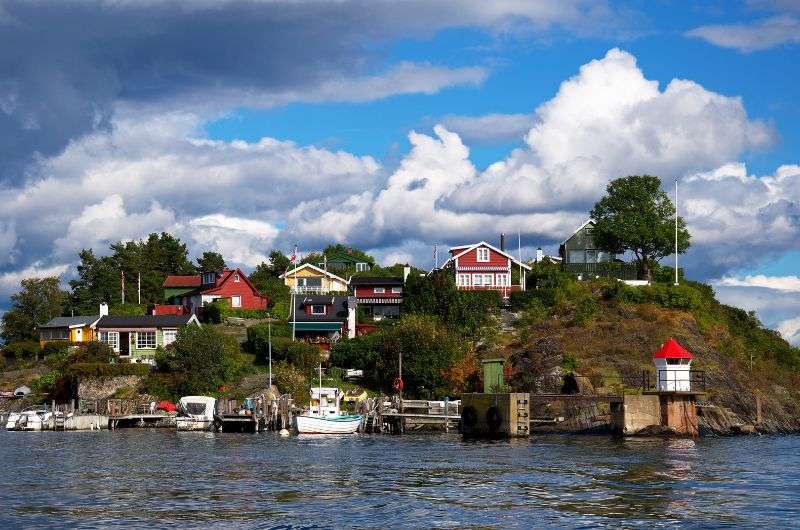
Marvellous Hovedøya Island
Afternoon, stop 3: Oslo Opera House
Off the ferry from Hovedøya and a half-hour walk into the city center, climbing the Opera House is a very niche Oslo activity. Think of it like a hike, but up a granite-and-marble feat of urban modernism, and it’s over in about 20 minutes.
The sloped roof of Oslo Opera House is public access, designed so you can climb up for panoramic views of the city, harbor, and fjord. It’s quick, fun, and feels like you’re breaking a rule (you’re not, but still).
Built in the 2000s, this massive masterpiece is one of Oslo’s most iconic landmarks. In summer, they even host rooftop cinema showings! If the sun’s out, the light is gorgeous, but if it’s raining? Go carefully—the marble turns into a slippery death trap (or so I can imagine, because it happened to be great weather on our Thursday of thrills).
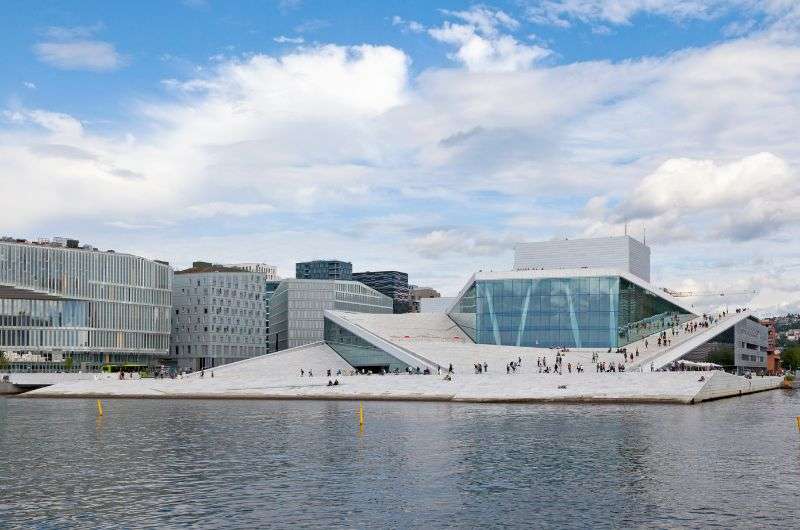
Oslo Opera House... loved the modern design in contrast with the more traditional buildings in the city
We’d had enough excitement by this time and didn’t feel the need to venture inside the building. But if overpriced, warbly, pretentious stage productions are your thing, by all means, go ahead.
Evening: go fine dining
During my time on our Norway road trip, I was convinced that fine dining seems to be the way to go in this country. Sure, you pay for it, but it’s fairly pricey to eat out anyway, and what you get in return for a negligible difference is off. The. Scale.
Now, I’m not suggesting you indulge in food this sublime every night on your Norway itinerary. (As high as my hopes are for this blog, I don’t suspect it’s a hit with the world’s millionaires just yet.) But your last dinner is the perfect opportunity to lap up a little luxury. And I can assure you that Statholdergaarden on Rådhusgata will not disappoint in this area.
As you’d expect from a Michelin-starred restaurant, hallelujah, for once in this country, you’ll get great service! The dining area is all 1600s-inspired decor, and the food itself? Sublime. We had the five-course tasting menu, and my mind was blown in three distinct ways....
One: How can you possibly make food on a plate look that pretty? Two: How can five tiny dishes fill you up like they do? And three: What kind of alchemy is going on in that kitchen to make it all taste so incredible?!
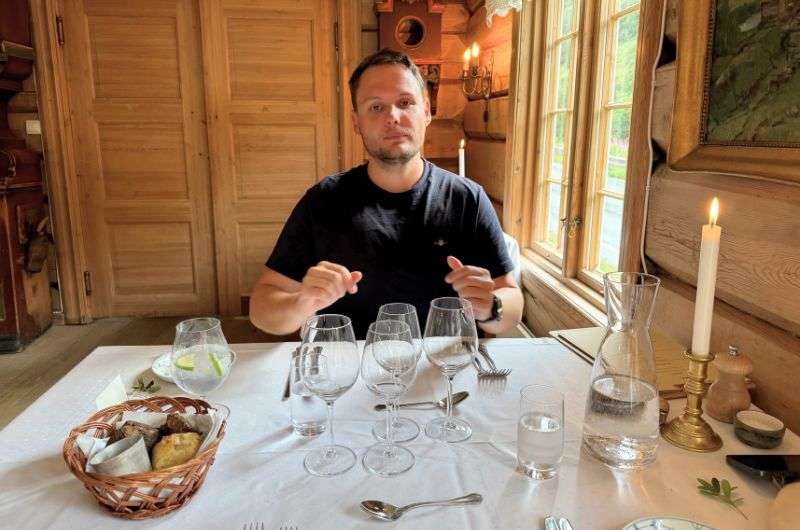
You can think of me as a restaurant critic who takes his job very seriously. You see?
This place is top gastronomy and in fact, was once named the best restaurant in Oslo. It’s understandable if you don’t have the money for this spot—this was a one-off treat for us, and restaurants are even more expensive in Oslo than they are in the countryside. But even if you don’t go to Statholdergaarden, do eat something tasty to celebrate your week of adventure.
Important note: You must book a table at Statholdergaarden in advance. Visit statholdergaarden.no for more details.
Can you do Norway in 7 days?
You can do Norway in 7 days, but you need to come prepared with a concrete itinerary. Norway is a pretty big country, and you need to be prepared for long drives all week if you want to get around all the must-sees. But the bottom line is, it is feasible to visit all the best places between Stavanger and Oslo in just 7 days.
If you want more time in Norway, be sure to check out my alternative, 14-day itinerary.
Where is the best place to visit in Norway for the first time?
The best thing for first-time visitors to do in Norway is hit the fjords, particularly Lysefjord (near Stavanger), Aurlandsfjord and Nærøyfjord (near Flåm), and Geirangerfjord (near Geiranger). These four are considered the most beautiful fjords in Norway, and there’s plenty to do and see around them: amazing hikes, high waterfalls, boat trips, and more.
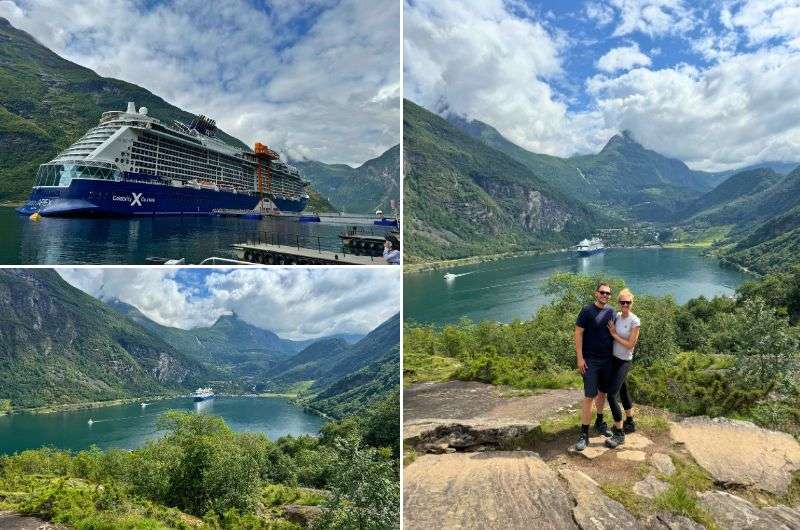
These pictures are from Geirangerfjord
When is the best time to visit Norway?
In my opinion, June to August is definitely the best time to visit Norway, with July being the warmest month. Long days, midnight sun, and ideal hiking weather make summer the peak season. Just be prepared for crowds and higher prices.
Many activities on this itinerary depend on a summer visit (e.g. the Viking Valley in Gudvangen is closed during the winter). For a comprehensive breakdown of what Norway is like in each month of the year, including when you can see the northern lights in Northern Norway, see my article on the best time to visit Norway:

Can you see Norway without a car?
Yes, you can visit Norway without a car, but only if you’re happy seeing a handful of tourist attractions (such as in Oslo and around Lysefjord), if you want to stay in one region, and/or if your Norway itinerary is a nutshell tour. Norway’s trains, buses, and ferries are top-notch, but it’s more difficult to reach more off-the-beaten-path places if you don’t have a car.
Personally, I wouldn’t recommend trying to see Norway without a car, especially seeing as this itinerary is a road trip.
Sometimes, all you need to do is take the first step... I've filtered out the best hotels in Norway for you
Save it for yourself to come back to later, or share with your friends on social media!
You might also be interested in reading:
- The Best 1-Week Norway Road Trip
- 11 Must-See Places in Norway
- 7 Epic Norwegian Fjords + Activities
- Hiking Pulpit Rock: My Experience
- The Best Time to Visit Norway
This post contains affiliate links. I earn a small commission if you make bookings through my links, at no additional cost to you. Thank you for your support!




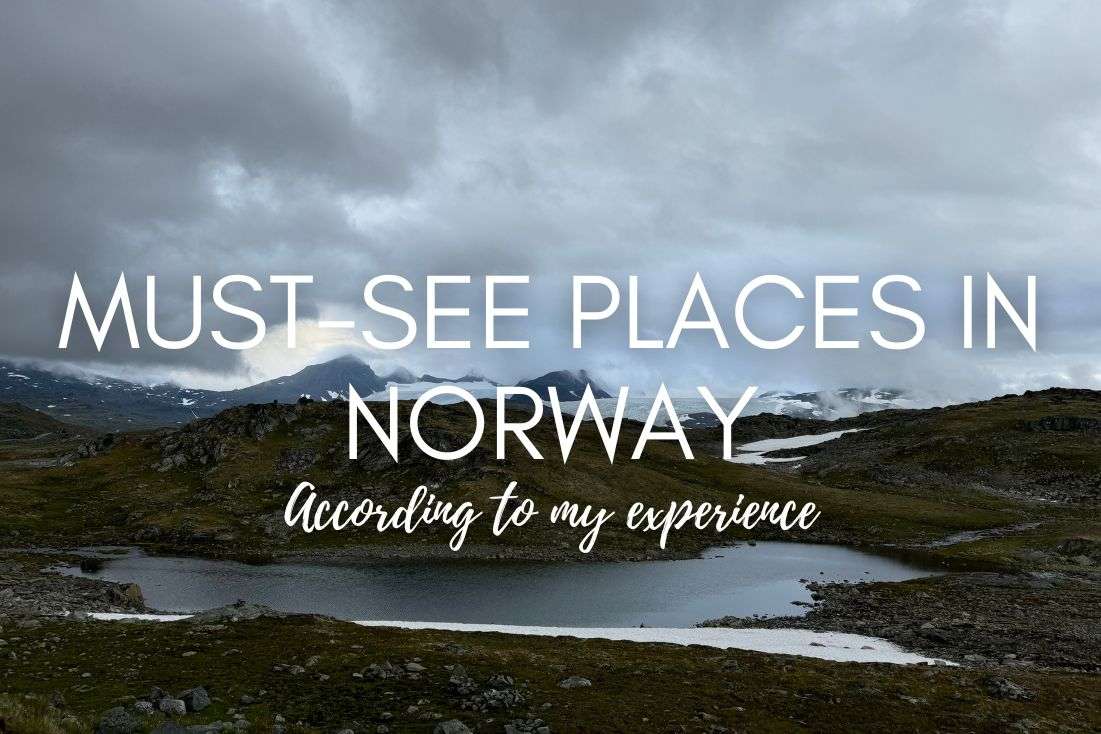
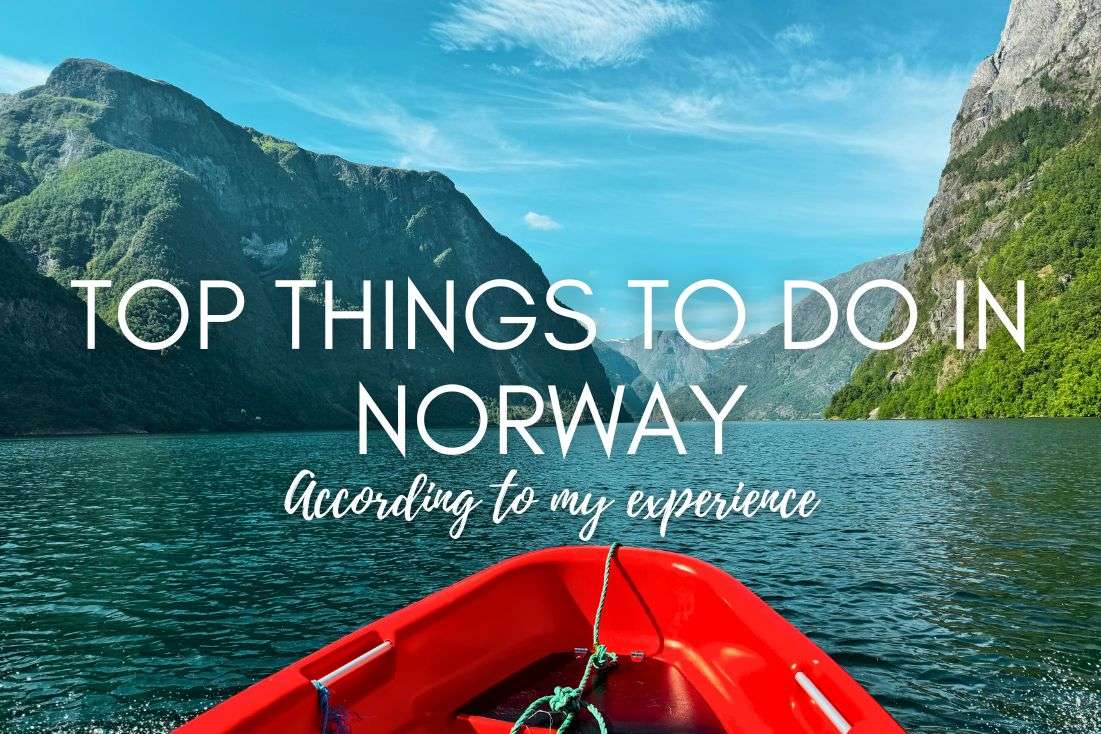
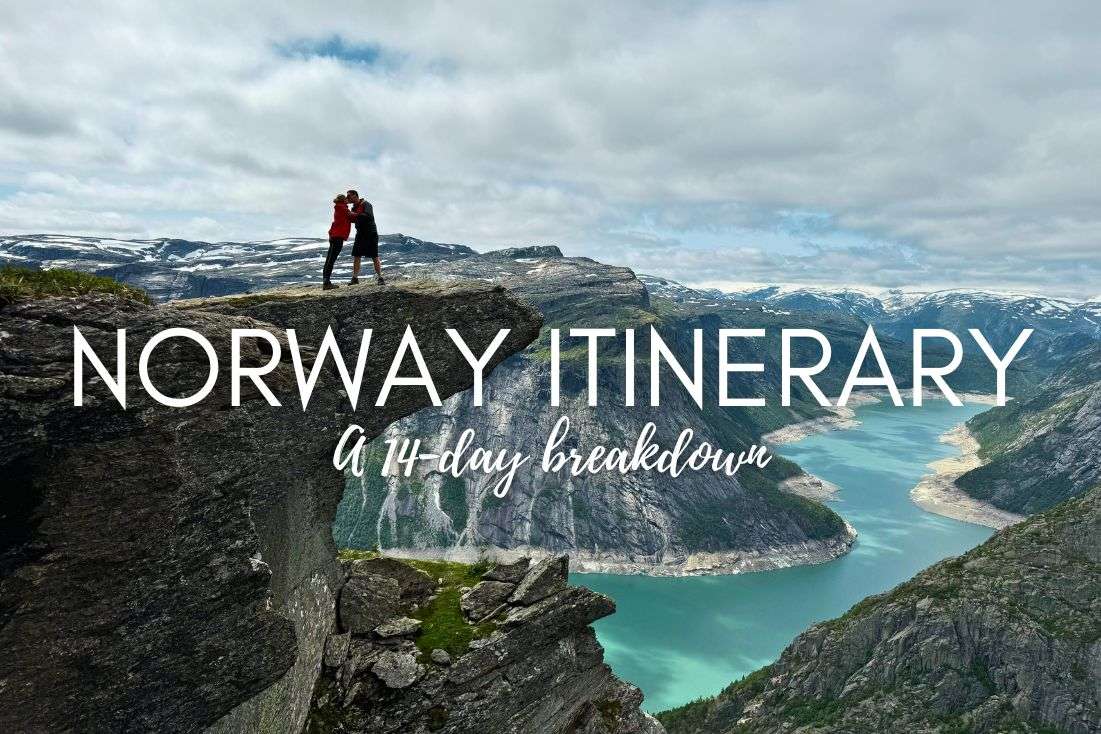



Comments | Thoughts? Give us a shout!